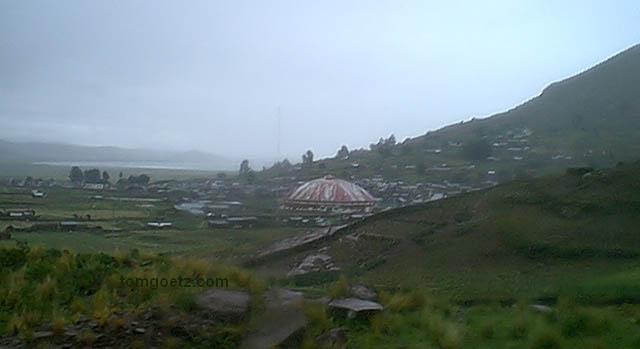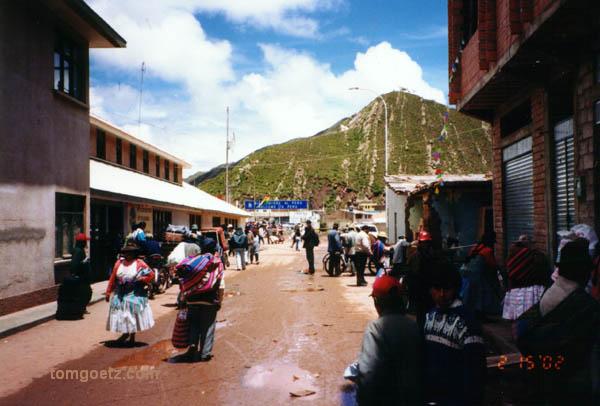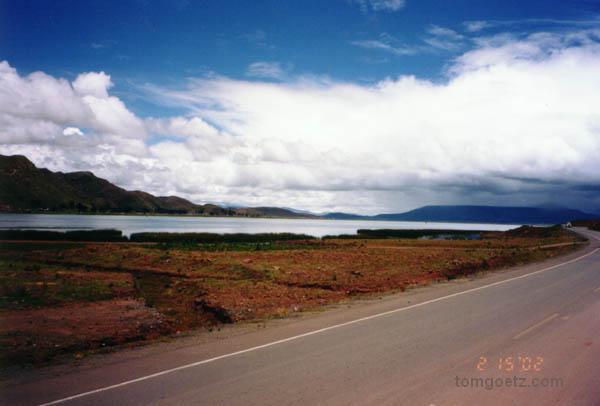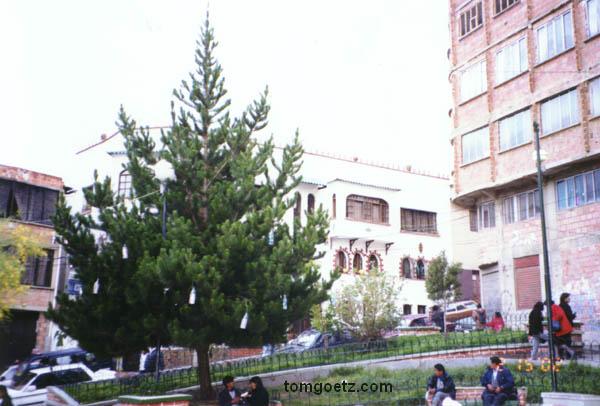Friday, February 15, 2002
It was 59 degrees in our room when we woke up. Okay to sleep in under heavy blankets, but hell getting up. Olegario was waiting in the lobby for us at 7:00 a.m. to put us on the bus, just like he promised. We were on the gringo bus. It's cheaper to take a collectivo, but much more crowded. And it's only ten bucks anyway to do it the "expensive" way, so who cares?

Juli, Peru
We drove along Lago Titicaca, and an hour and a half later we were in Desaguadero for our border crossing. They had a crazy mercado thing going on in the streets, and the place was a muddy mess. The parking was the least organized thing I've ever seen. Desaguadero was extra crowded and crazy due to the route through Copacabana, the more popular border crossing point, being closed. But we managed through and changed some money and even caught the correct bus on the other side to continue on to La Paz.

La Frontera en Desaguadero
In the next couple of kilometers we had to show our passports twice more to prove we'd had them stamped at the border. Like who the heck do they think is trying to sneak into Bolivia anyway? At one of the checkpoints I bought a papa relleno and a papa relleno con res for one boliviano each. Tom and I split them, so we ended up eating lunch this day for a bargain price of around 15 cents each.

Lago Titicaca en Bolivia
On the outskirts of La Paz we encountered some snow, and we saw an indigenous family having a snowball fight. We then passed a construction crew composed entirely of women digging a ditch. The strange part to me was that they were all wearing skirts. The indigenous women wear derby/bowler hats, voluminous skirts, and two long braids. They all have a baby or a bundle tied on their backs wrapped in bright-colored cloth. Bolivia is going to be different.
La Ciudad de Nuestra Señora de La Paz (population 2.5 million; 11,975ft/3650m) lies nestled in the Chuquiago Marka Valley, with shanty-towns crawling up the sides of the valley. The poorer you are, the farther up the mountain you live. The view while descending into La Paz is extraordinary.
The bus dropped us off, and we immediately hopped in a taxi to the Arcabucero Hostal Inn. Despite the staff not speaking any English, we managed to secure accommodations. We got a double with a private bath and breakfast. The common area of the hostal is a very nice solarium, and the place is spotless. A small park outside our window features a tree decorated with empty plastic bottles. We don't know why.

La Vista desde el Hotel Arcabucero
Traveler recommendation: If you ever go to La Paz, you must eat at the Roman Palace, 266-A Santa Cruz. Their food is awesome! We were the only customers for our early dinner at 5:00, and they turned on disco music in our honor, but I'm sure they'd refrain from doing that if you asked them. We had cream of onion soup, lomo pimiento, spaghetti, a liter of beer, and two liters of water for less than $12. And it was all superb! It's crazy how cheap Bolivia is.
La Paz is like one huge market. The streets are full of vendors selling anything. You don't need to go inside to buy things, only services. Walking back to our hotel, we saw dried llama fetuses for sale at the Witches' Market. They're supposed to be good luck and you can bless your house with them. Alas, we did not know in what way they were to be used, so we did not buy any.